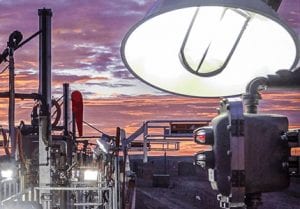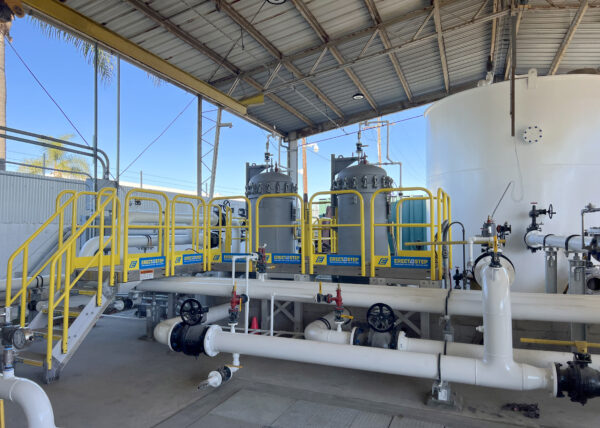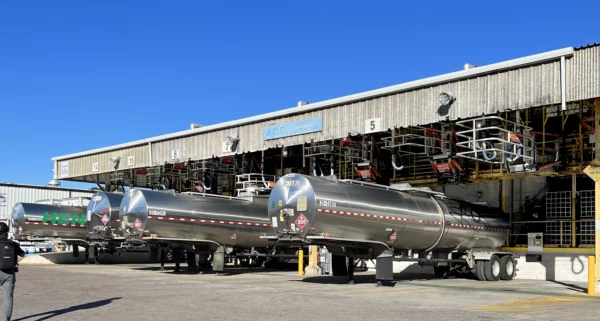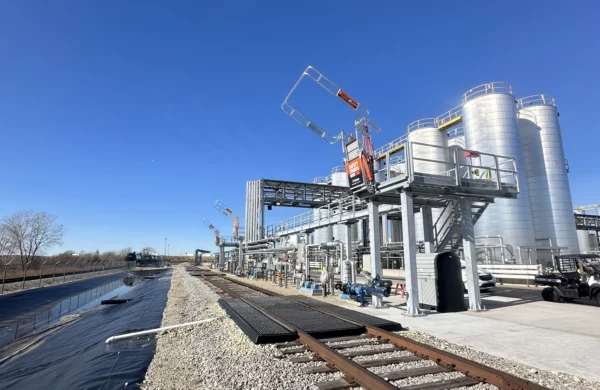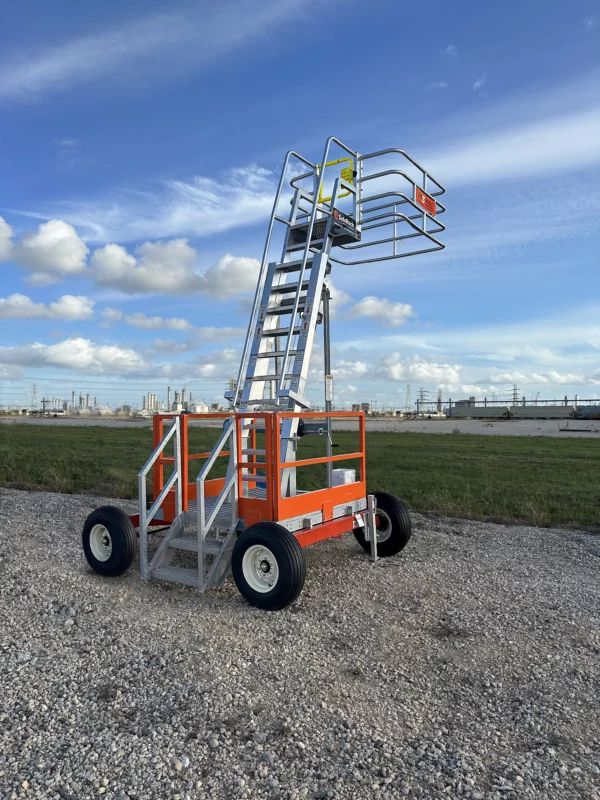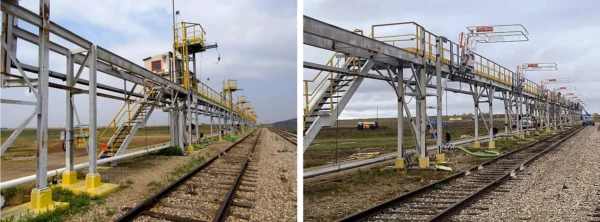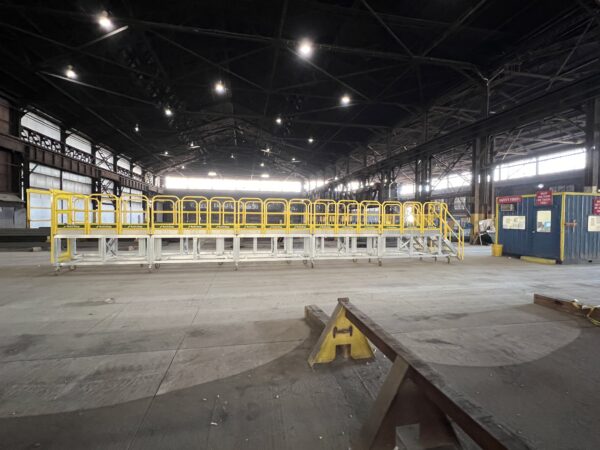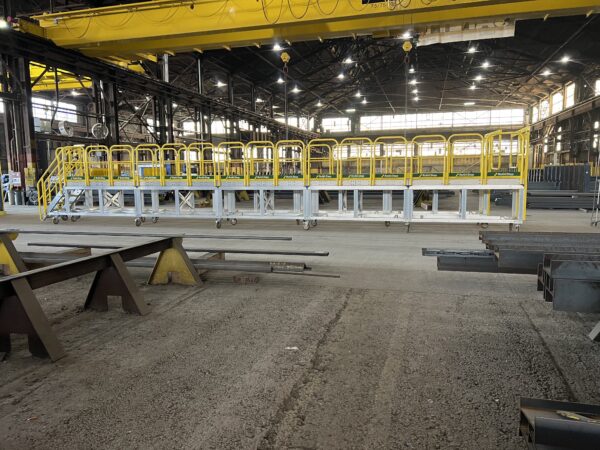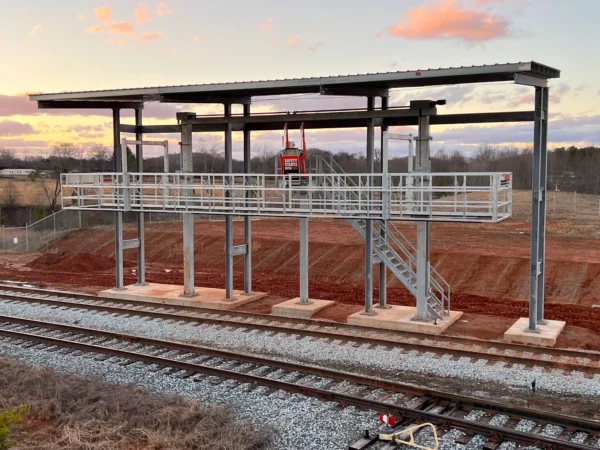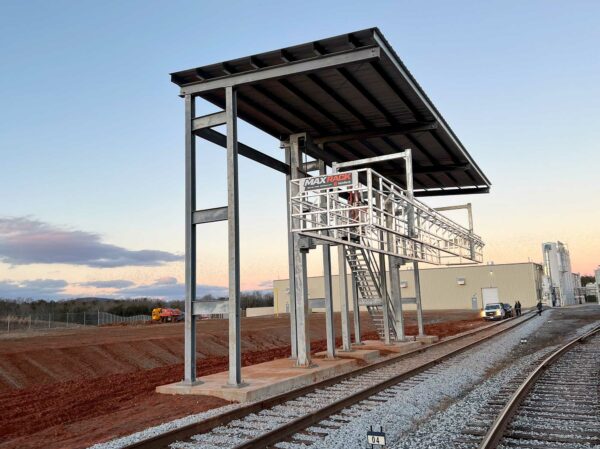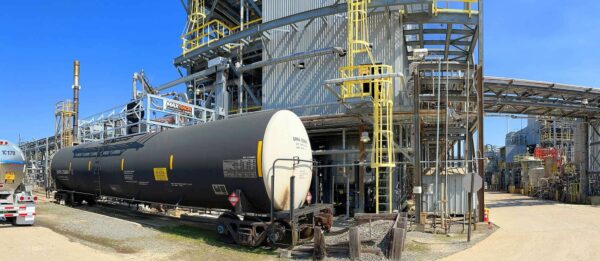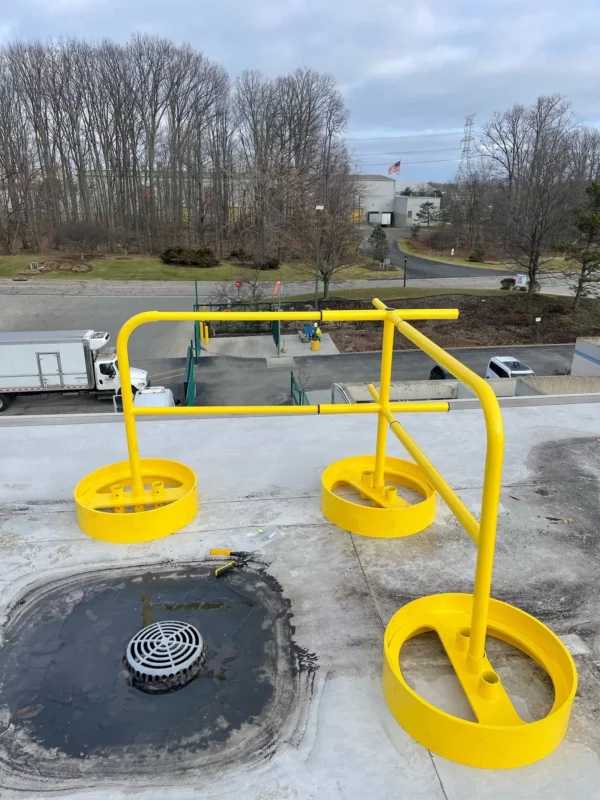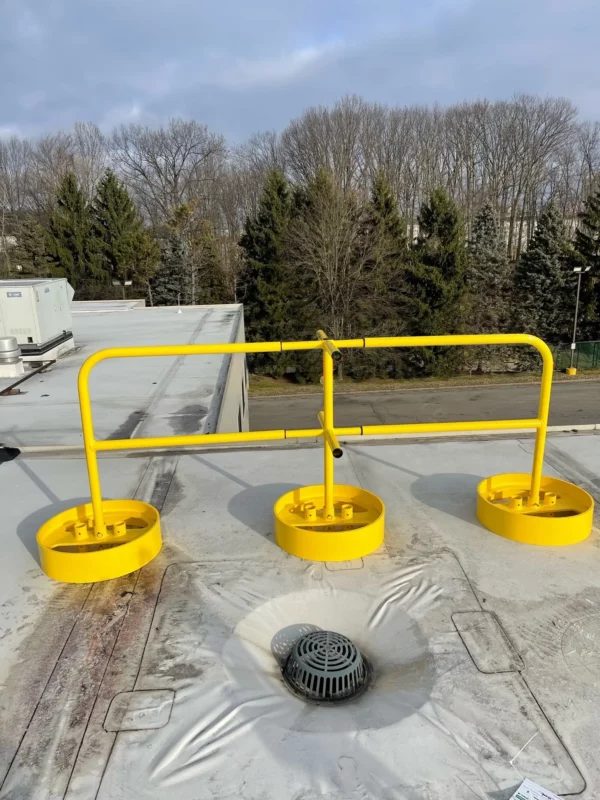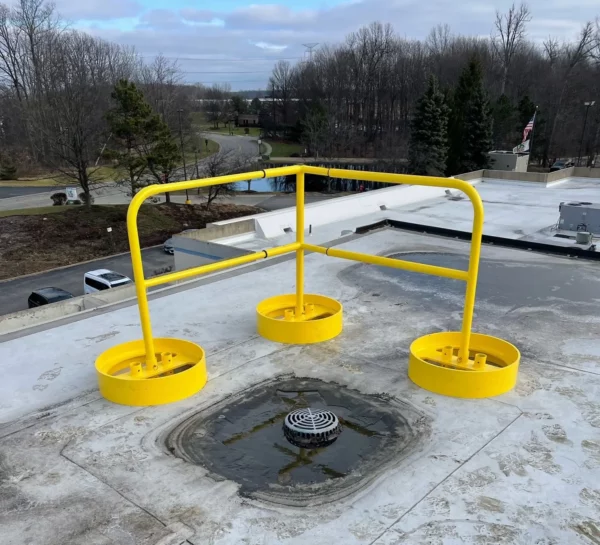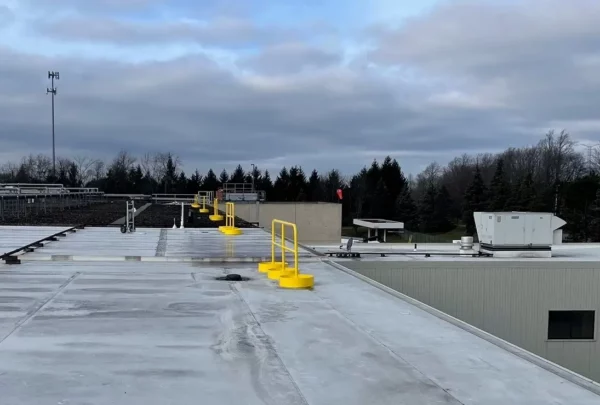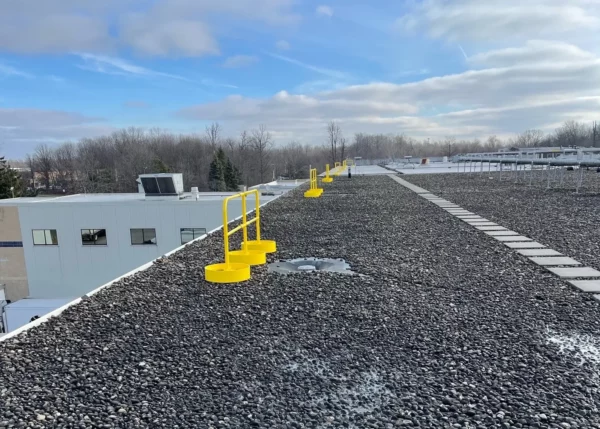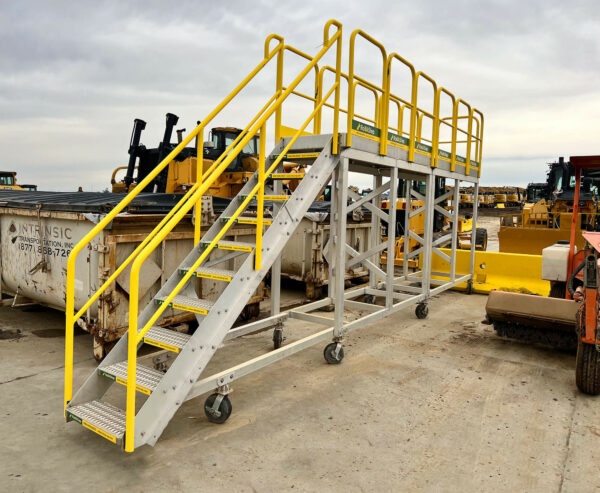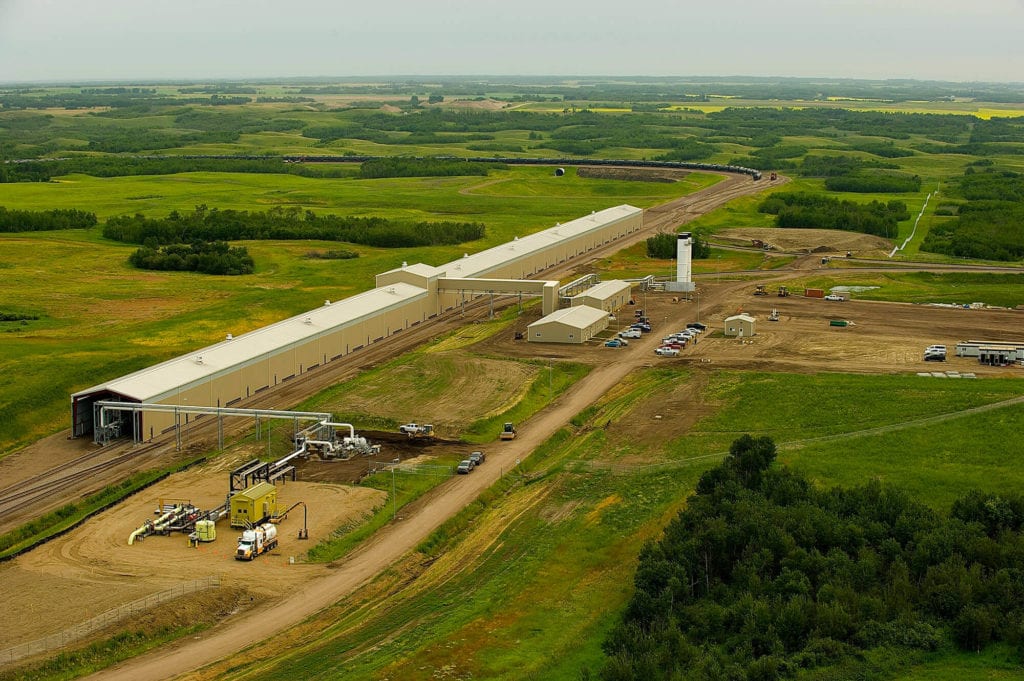Get a quote, configure a custom safety solution or ask a question. We're here to help!








- Spill ContainmentMore …Loading Safety CagesMore …
SafeRack Worldwide
We pride ourselves on one-on-one customer service. When you call SafeRack, we'll be there to answer your questions with a combined experience of 400+ years.
Select your region below.- View Products
- Railcar & Truck Loading Platforms
- Gangways & Loading Ramps
- Stairs, Platforms & Ladders
- Mobile Ladders & Platforms
- Loading Arms & Fluid Transfer
- Safety Gates & Traffic Control
- Aviation & Aerospace Access
- Marine Access & Loading
- Grounding & Monitoring
- Spill Containment
- Loading Safety Cages
- Transloaders & Skids
- Shelters & Canopies
- Fall Protection
- Terminal & Speciality
Home / Industries / Bulk Chemical Loading / Hydrogen CyanideHydrogen Cyanide (HCN) Handling Design, Loading, and Installation.
Although no two Hydrogen Cyanide (un)loading solutions will be identical, the product itself determines much of the critical design criteria that will ensure that optimum safety and productivity can work together in harmony.
What is Hydrogen Cyanide? Hydrogen Cyanide, also known as hydrocyanic acid, prussic acid or HCN can be used as a chemical warfare agent, but it’s commercially used for fumigation, mining, chemical synthesis, electroplating, and in the production of synthetic fibers, plastics, dyes and pesticides.
In the United States, Hydrogen Cyanide is a “tight-fill” (closed-loop) (un)loading operation and is loaded into rail cars via chemical hoses, 316 stainless steel or 3” PTFE lined loading arms. Hydrogen cyanide if not handled properly can cause serious injuries and Personal Protective Equipment (PPE) is required. Additionally, because operators are on top of the vehicles during the loading process, robust, well-designed fall prevention is essential to ensure increased throughput, without compromising operator safety.
Hydrogen Cyanide is typically shipped in specially built 20,500 gallon DOT-105 rubber lined, insulated tank cars with high pressure safety valves. The rails cars themselves are ~ 9′ outside diameter with an overall length of ~45′ to 50′, with a 6’x 6′ center opening crash box openings. Railcars are typically painted white with red bands or “candy stripes” for quick identification.








Question, Get a Quote, Live Demo or Request an On-Site Visit
Our experts simplify the complex
View Full TextTank truck (un)loading procedures are similar to railcar applications with the trailers meeting established DOT requirements for transporting aluminum sulfate or other similar commodities. Approved DOT trailers include MC 307 chemical ISO containers. Trailers and ISO’s are typically bottom unloaded. An extension pipe with two valves is flanged to the top of the trailer.
All trailers must be equipped with pressure relief valves, and trailers with bottom outlets must be equipped with remote controlled stop valves.
Typical Hydrogen Cyanide Loading Platform
Quote or discuss your installation.
Start by selecting loading application"*" indicates required fields
Below are some of the loading and unloading solutions for illustrative purposes only. Our experts will work with you and your team for a custom solution to suit your needs.
Hydrogen Cyanide Loading Arms

Hydrogen Cyanide is typically loaded into railcars or tank trucks via boom supported 316 stainless steel, PTFE lined loading arms or chemical hoses with flanged end connections. The arm or hose will have a top inlet with a control valve to ensure that it is self-draining after use and is supported along the length of a mechanical loading arm to improve handling; this is known as a by-pass arm. You can install one liquid and one vapor arm, or mount both the liquid and vapor hoses on one by-pass arm. For unloading, typically you would use a rigid self-draining stainless steel or PTFE lined loading arm with ChemRaz (FFKM), Kalrez or PTFE seals. Purge lines can be fitted to the arm, for nitrogen purging. Additional features such as parking latches with proximity sensors can be incorporated into the total system to ensure the arm is correctly stowed when not in use before any rail movement can occur.
Loading Gangways and Safety Cages

A wider access gangway (48″-60″ is preferable) as it helps improve access and egress to and from the vessel. In addition, a wider gangway will reduce the risk of the operator’s PPE getting caught, torn, or damaged, and will improve productivity and safety. Powered gangway solutions are also an option, with both hydraulic and pneumatic solutions being commonly used. Each gangway will be fitted with a two-rail safety cage for the railcar crash box. This will be a centered 6’x6’ safety cage to sit directly over the cashbox. This will provide a safe, secure work environment for your operator when connected to their breathing apparatus.
GX Self-Adjusting Stair (SAS) Gangway

SafeRack’s GX SAS gangways use Retractalok power-assist technology allowing operators to raise or lower effortlessly, light as a feather to lift, and solid as a rock. Tested in the most critical applications, this revolutionary new gangway outperforms all others. Available in multiple lengths and widths.
Learn MoreMAXRack Elevating Safety Cage
 As an alternative to our two and four-rail safety cages, some customers prefer our MAXRack elevating safety cages. The ultimate fall prevention solution engineered to keep operators safe and productive. Designed for both trucks or railcars, and available in multiple cage lengths and widths. Safe, durable, and easy to use. MAXRack is built rock-solid with galvanized steel column supports and lifting arms (cages can be Aluminum, Galvanized, or Stainless Steel depending on application) Available in two power options – Pneumatic Air Drive and Electric Drive (Explosion and Non-Explosion Proof).
As an alternative to our two and four-rail safety cages, some customers prefer our MAXRack elevating safety cages. The ultimate fall prevention solution engineered to keep operators safe and productive. Designed for both trucks or railcars, and available in multiple cage lengths and widths. Safe, durable, and easy to use. MAXRack is built rock-solid with galvanized steel column supports and lifting arms (cages can be Aluminum, Galvanized, or Stainless Steel depending on application) Available in two power options – Pneumatic Air Drive and Electric Drive (Explosion and Non-Explosion Proof).
Learn MoreHydrogen Cyanide Wash Eye Wash/Drench Showers

ANSI guidelines state that an Eye Wash/Drench Showers need to be located 10 seconds or 55’ (16.8m) from contaminants or hazardous materials. Eyewash stations need to be on the same horizontal plane with no obstructions.
Therefore, we would propose the installation of a standard combination Drench Shower/Eyewash Unit, which will save limited space and fit easily into any work environment.
Hydrogen Cyanide Spill Containment

Spill containment pans will be provided at the point of loading operations and is an essential piece of equipment in overall site safety and environmental protection.
Railcar spill containment and track pansHydrogen Cyanide Grounding

Hydrogen Cyanide is an extremely flammable liquid and vapor; therefore industry best practice includes the grounding of all vessels before starting the (un)loading process. - Ground controllers — ensure true grounding before product flow is permitted
- Explosion-proof enclosures — meet or exceed UL, CSA and Ex requirements
- Non-sparking tools are also recommended while working around this product
Hydrogen Cyanide Safety Gates

Safety Gates will be installed at the top of stairs and any other openings to ensure operator safety at all times.  YellowGate Safety Gates
YellowGate Safety GatesSafeRack’s line of industrial safety gates is the most flexible product on the market with the ability span openings between 16″ and 36″ and is field adjustable with nothing more than a wrench. Learn More
Hydrogen Cyanide Options

- Lighting – Lighting both over and under the platform will be provided. For overcast days or second shifts, lighting is essential for improved safety and improved productivity.
- Platform & Canopies – Full platform canopies reduce exposure to the elements and improve the safe and productive loading operation from the operator’s perspective.
- Operator Shelter – Depending on your site requirements, consideration should be given to the requirement of an operator or guard building on the loading platform. This can be customized to meet specific site requirements.
- Wheel Chocks – Railcar Wheel Chocks provide fast blocking of all types of railcars and meet OSHA regulations to safely prevent railroad cars from moving during loading or unloading operations. This is a requirement by the Department of Homeland Security.
Personal Protective Equipment PPE Requirements
Eye/Face Protection: Wear chemical safety goggles. The use of a respiratory device to protect against the effects of fumes, dust, and aerosol is also recommended.
Skin Protection: Wear chemical protective clothing e.g. gloves, aprons, boots. Coveralls or long sleeve shirts and pants in some operations. Wear a chemical protective, full-body encapsulating suit, and self-contained breathing apparatus (SCBA). Suitable materials include: butyl rubber, neoprene rubber, Viton®, Viton®/butyl rubber, Barrier® – PE/PA/PE, Silver Shield® – PE/EVAL/PE, Trellchem® HPS, Trellchem® VPS, Saranex®™, Tychem® BR/LV, Tychem® Responder® CSM, Tychem® TK. The following materials should NOT be used: natural rubber, polyvinyl chloride. Recommendations are NOT valid for very thin neoprene rubber gloves (0.3 mm or less).
Respiratory Protection: Up to 3 ppm:
(APF = 10) Any chemical cartridge respirator with cartridge(s) providing protection against chlorine*; or Any supplied-air respirator*.
*Reported to cause eye irritation or damage; may require eye protection.
Recommendations apply only to National Institute for Occupational Safety and Health (NIOSH) approved respirators. Refer to the NIOSH pocket guide to chemical hazards for more information.
Use a local exhaust ventilation and enclosure, if necessary, to control the amount in the air. Consider using a corrosion-resistant exhaust ventilation system separate from other ventilation systems. It may be necessary to use stringent control measures such as process enclosure to prevent product release into the workplace. Use backup controls (e.g. double mechanical pump seals) to prevent the release of this material due to equipment failure. * For illustrative purposes only. Our experts will work with you and your team for a custom solution to suit your needs. Customer Reviews
 5 5Before and after sales staff was amazing, very helpful.
5 5Before and after sales staff was amazing, very helpful.We needed a mobile stair platform and Saferack delivered on time with the correct order.
By Ray Litz from ArcelorMittal Shelby on 7/23/19 5 5Easy to maneuver and operate.
5 5Easy to maneuver and operate.I would recommend the SafeRack MAUI for trucks – it’s easy to maneuver and operate.
By Jerry Crowder from Kinder Morgan on 6/1/115 5Quick response.I appreciated the quick response by the Jason Stuart in evaluating the project and providing the necessary information for us to select the best product for our application. The product was delivered as promised, per the limited time frame. It will provide the necessary level of protection needed with maintenance-free construction. The price was competitive with other providers.
By Project Engineer from Large Refinery in New Mexico on 12/16/105 5The flat ramp gangway is great and we appreciate the follow-up from our rep.The loading rack has already been installed….great product ! I enjoyed working with Travis & Heather, specifically their follow-up. I would consider them very responsive and the product was delivered as advertised.
By Steven Gerbasi from Cleveland Industrial Group on 12/3/10 4 5Easy transaction, quick delivery, easy to install.
4 5Easy transaction, quick delivery, easy to install.Easy transaction, quick delivery, easy to install.
By Daryl Brye from Gundersen Health System on 12/3/15 5 5Our new flat-ramp gangway is a major improvement from what we had.
5 5Our new flat-ramp gangway is a major improvement from what we had.Travis was very responsive and the product was delivered very quick. The product works well, it was a step up from what we had.
By Chris Denton from Nestle on 12/3/10MAJOR HYDROGEN CYANIDE PRODUCERS WHERE WE HAVE SUCCESSFULLY EXECUTED HYDROGEN CYANIDE LOADING PROJECTS
Hydrogen Cyanide 101
Things to know about Hydrogen Cyanide
Hydrogen Cyanide is regulated by the U.S. Department of Transportation (DOT) and is classified as a flammable and hazardous material with the DOT identification number UN 1051.
Hydrogen Cyanide is a volatile colorless to light blue liquid or gas with a bitter almond-like odor. A solution of HCN in water is also referred to as hydrocyanic or prussic acid. This poisonous and corrosive liquid or gas is used primarily in the manufacturing of fumigants; electroplating; the production of nylon and other synthetic fibers; and plastics and dyes.
Only properly trained and equipped personnel should be permitted to handle hydrogen cyanide tank cars and tank trucks. Operators should wear approved PPE equipment including impervious clothing, footwear, gloves, and a respirator.
HCN is dangerous to human health, as it disrupts the body’s use of oxygen and may cause harm to the brain, lungs, blood vessels, and heart. Do not breathe dust/fumes/mist/vapors. The legal airborne exposure limit is 10 ppm averaged over an 8-hour work shift. Exposure of 130 ppm can be fatal after 30 minutes and concentrations above 180 ppm can be fatal within minutes.
First aid measures for exposure include – removing operators from the source of exposure and into fresh air. Remove contaminated clothing immediately; wash skin thoroughly with soap and water; flush eyes with tepid water for 15 minutes and seek medical attention. Exposure to HCN in a gaseous state can cause burns or frostbite.
Hydrogen cyanide best practice includes storing away from direct sunlight in a cool, dry environment in well sealed containers, and away from amines, oxidants, acids, sodium hydroxide, calcium hydroxide, caustic substances, and ammonia. Avoid storage near extreme heat, ignition sources or open flame.
HCN is corrosive to some metals including brass, cast iron, and copper; however, aluminum, carbon, galvanized or stainless steel are acceptable materials for construction.

Is your plant or facility compliant with ANSI, OSHA, and local safety codes? We can help!


EMERGENCY EYEWASHES / SHOWER EQUIPMENT AND THE ANSI/ISEA Z358.1 – 2014 STANDARD
Following eye contact, you must start washing with water immediately to prevent permanent damage. In the event of skin contact, you must start washing with water immediately to prevent slow-healing chemical burns.
Are you aware that ANSI guidelines state that Eye Wash/Drench Showers need to be located 10 seconds or 55′ from contaminates or hazardous materials and located on the same horizontal plane, with no obstructions? If bottom loading/unloading, an additional shower should be located at grade as well. SafeRack provides the above equipment plus much more needed to keep employees safe and expedite bulk chemical loading and unloading.
OSHA Regulation Experts – Does your existing chemical safety equipment or chemical loading systems meet OSHA’s latest requirements? SafeRack’s professional technical sales consultants are available to meet with your team to make recommendations to keep your facility in front of OSHA’s ever-changing country and region-specific standards and regulations, including lifeline and trolley beam fall arrest systems, metal stairs, and access platforms.
Why SafeRack?
The SafeRack approach is a collaborative one. Let’s call it The SafeRack Way. We have, over many years amassed a great deal of experience and understanding of the safety aspects involved in loading road tankers and railcars, as well as the behavioral habits of the operators.

Experts In Chemical Loading
- Acetic Acid
- Acetic Anhydride
- Acetonitrile
- Acrolein
- Acrylic Acid
- Acrylonitrile
- Aluminum Chloride
- Aluminum Sulfate
- Ammonia
- Ammonium Hydroxide
- Ammonium Nitrate
- Aniline
- Benzene
- Benzyl Chloride
- Bromotrifluoromethane
- Butadiene
- Carbon Dioxide
- Caustic
- Chlorine
- Chloroform
- Chlorosulfonic Acid
- DEF (Diesel Exhaust Fluid)
- Diethylene Glycol
- Dimethylformamide
- Dodecylbenzene Sulfonic Acid
- Ethanol
- Ethyl Acetate
- Ethyl Chloride
- Ethylene
- Ethylene Dichloride
- Ethylene Glycol
- Ethylene Oxide
- Ferric Chloride
- Ferrous Chloride
- Hexane
- Hydrochloric Acid
- Hydrofluoric Acid
- Hydrofluorosilicic Acid
- Hydrogen Cyanide
- Hydrogen Peroxide
- Hydrofluoric Acid
- Hypochlorous Acid
- Isopropyl Acetate
- Liquid Argon
- Liquid Nitrogen
- Liquid Oxygen
- Maleic Anhydride
- MDI
- Methanol
- Methyl Chloride
- Methyl Ethyl Ketone
- Methyl Methacrylate
- Methyl Isocyanate
- Molten Sulphur
- Nitric Acid
- Oleum
- Phenol
- Phosphoric Acid
- Phosphorus Oxychloride
- Phosphorus Trichloride
- Polypropylene
- Renewable Diesel
- Sodium Cyanide
- Sodium Hydroxide
- Sodium Hypochlorite
- Styrene Monomer
- Sulfuric Acid
- Sulfur Dioxide
- Titanium Tetrachloride
- Toluene
- Toluene Diisocyanate
- Turpenitne
- UAN (Urea Ammonium Nitrate)
- UREA
- Vinyl Acetate
- Vinyl Chloride
- Xylene
- Zinc Chloride
- Agro-Chemical
- Specialty Chemical
- Petrochemical

North America’s largest loading terminal
World-leading designer, manufacturer, and installer of truck and railcar loading platforms
As one of the primary railcar loading points, Hardisty is one of the major crude oil hubs in North America and a major origination point of pipelines that export to the United States. SCS was asked to supply and construct a SafeRack crude oil loadout terminal spanning nearly half a mile. The USD Hardisty terminal can load up to two 120-railcar unit trains per day and consists of a fixed loading rack with 62 railcar loading positions enclosed, separate control, operator, and mechanical buildings, as well as a unit train staging area and loop tracks capable of holding multiple unit trains simultaneously. SCS also supplied and installed boom-supported loading arms with supply and vapor management systems.

Quick Quote 866-761-7225
LET US DESIGN YOUR SOLUTION TODAY
Our innovative tools provide 3D visualizations and accurate quotes in minutes.
Get Help NowOrder Now 866-761-7225
Questions or Need a Quote?
Chat live with a knowledgeable and friendly safety expert now.

Bob Kashtan
Located in South Carolina

Joey Robinson
Located in South Carolina

Caelin Lacy
Located in South Carolina

Katie Kelly
Located in South Carolina

Amber Graham
Located in South Carolina






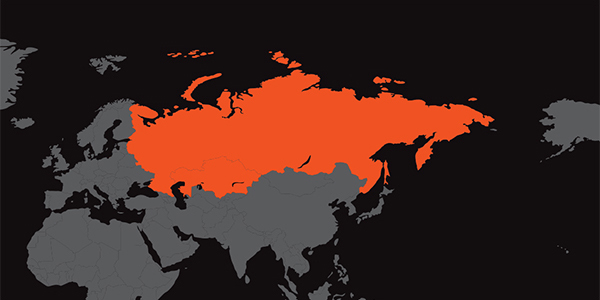





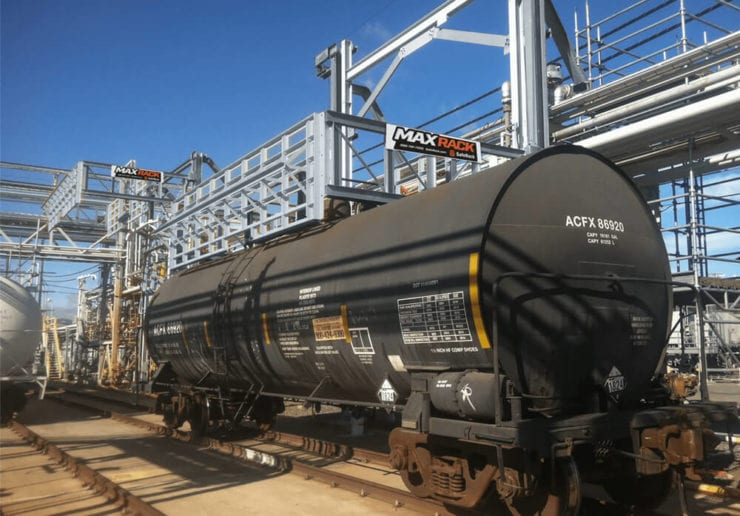

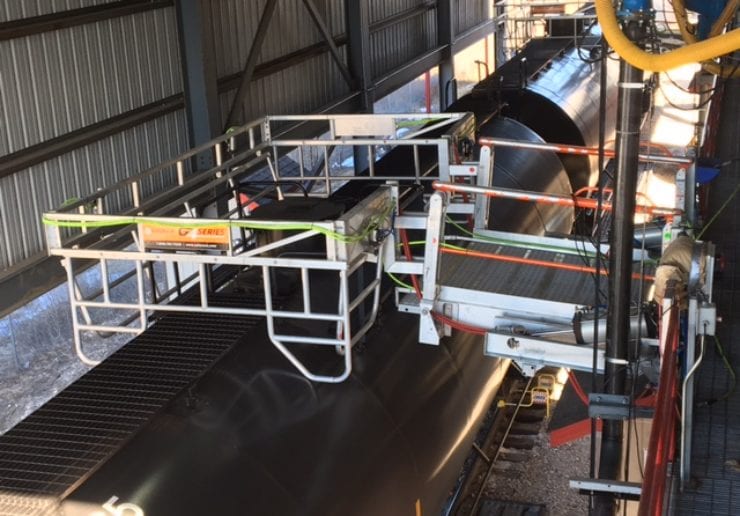

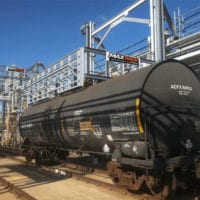
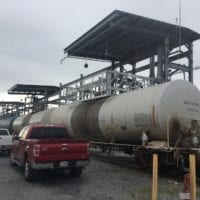
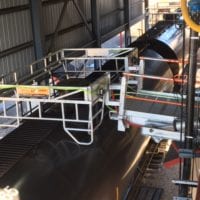


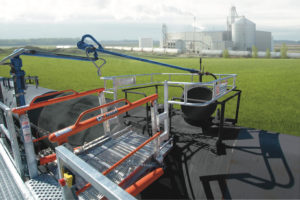
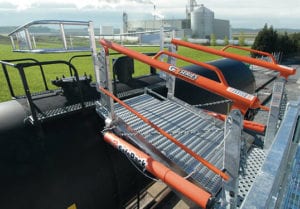
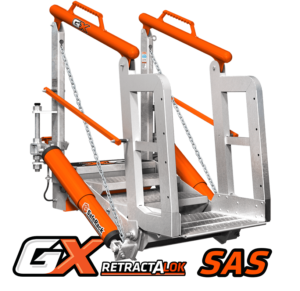
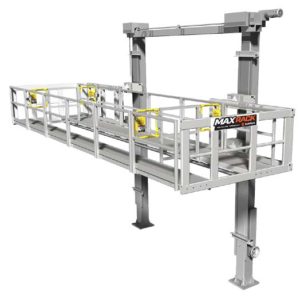 As an alternative to our two and four-rail safety cages, some customers prefer our MAXRack elevating safety cages. The ultimate fall prevention solution engineered to keep operators safe and productive. Designed for both trucks or railcars, and available in multiple cage lengths and widths. Safe, durable, and easy to use. MAXRack is built rock-solid with galvanized steel column supports and lifting arms (cages can be Aluminum, Galvanized, or Stainless Steel depending on application) Available in two power options – Pneumatic Air Drive and Electric Drive (Explosion and Non-Explosion Proof).
As an alternative to our two and four-rail safety cages, some customers prefer our MAXRack elevating safety cages. The ultimate fall prevention solution engineered to keep operators safe and productive. Designed for both trucks or railcars, and available in multiple cage lengths and widths. Safe, durable, and easy to use. MAXRack is built rock-solid with galvanized steel column supports and lifting arms (cages can be Aluminum, Galvanized, or Stainless Steel depending on application) Available in two power options – Pneumatic Air Drive and Electric Drive (Explosion and Non-Explosion Proof).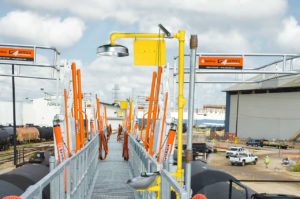
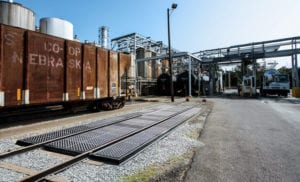
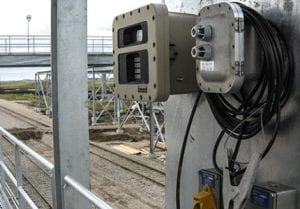
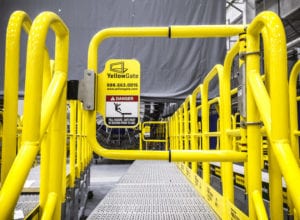
 YellowGate Safety Gates
YellowGate Safety Gates